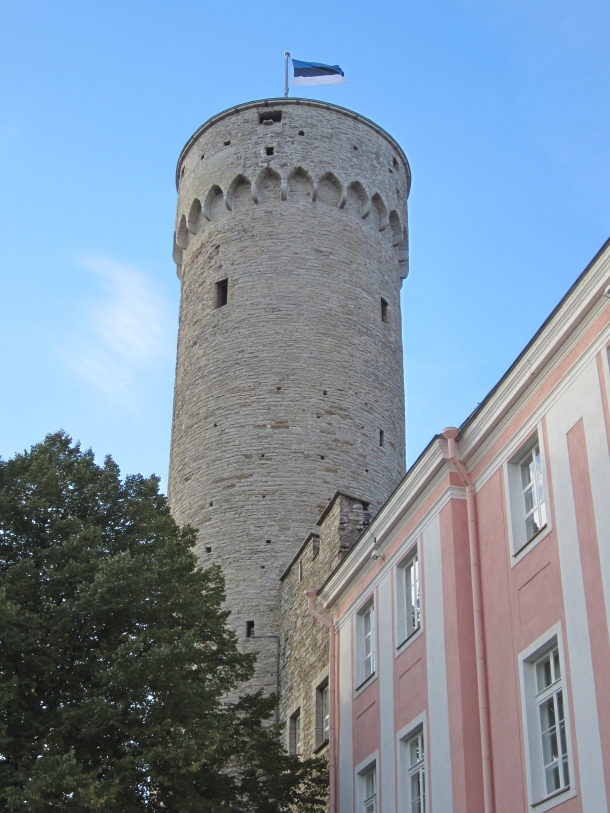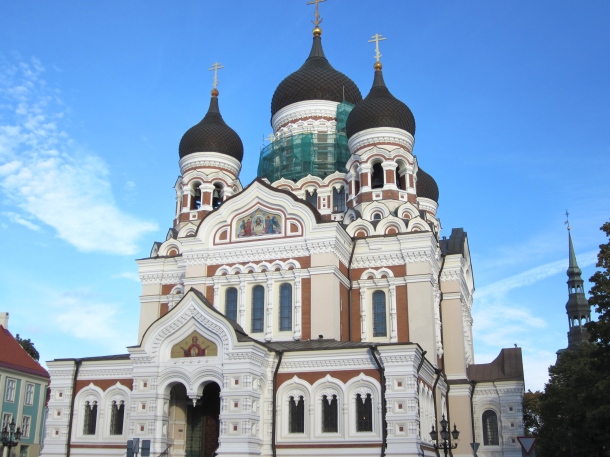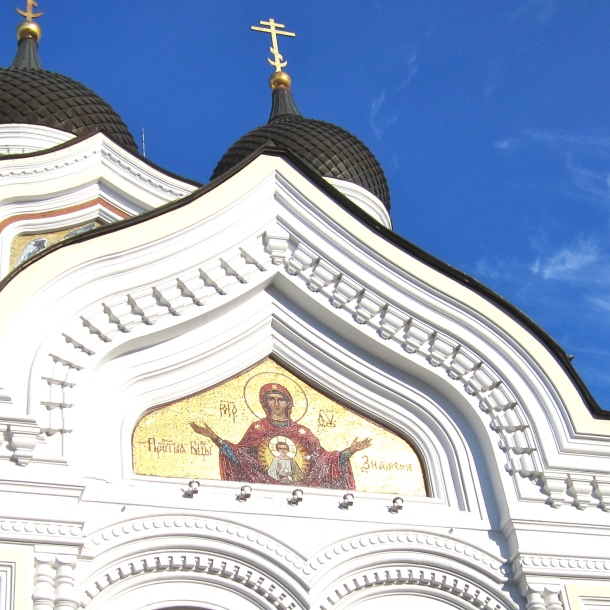How could anyone object to this beautiful Russian Orthodox cathedral? It’s certainly a spectacular building, but in Tallinn, Estonia in 1900, it sent a loud-and-clear political message to an unruly Baltic territory: Czar Alexander III and his Russian government were in control.
There’s no denying its aesthetic appeal, but its distinctive Russian style and location made the message impossible to miss. Strategically located on the former site of a statue of Martin Luther, and directly across the square from Tallinn’s Toompea Castle (the seat of their government), the cathedral raised the hackles of many Estonia nationalists. In fact, the church was so controversial that there was a plan for its demolition in 1924, which luckily, wasn’t carried out.
The controversy faded long ago, and what’s left is an architectural masterpiece. It’s called the Alexander Nevsky Cathedral, and it’s a good reason to leave Tallinn’s Medieval Historic district, and hike up the hill to the “Upper Town.”
Before visiting this cathedral I hadn’t thought much about the message that architecture sends. But after some thought, I realize that it’s unusual if a building doesn’t send a message – political or otherwise.
Do you have a building that appeals to you, and like (or dislike) the message it sends? I’d love to hear.
Happy Trails,
James
Last Updated September 7, 2023




I LOVE the beautiful Russian Cathedrals!!
I too am partial to Russian and Eastern Orthodox cathedrals Janaline. I think for me that it’s the combination of onion domes, arches, and bright colors. Very distinctive. ~James
Was just reading this morning that architecture is a conversation:
http://conflatedautomatons.wordpress.com/2014/02/17/lines-of-sight/
It’s true, there are the individual buildings (messages) but also the interplay between those around them.
You make a valid point Bronwyn. Architecture, and how it fits into its surroundings is something that many people take personally. If the building is too modern and different, some complain that it doesn’t fit in. And if the building fits in too well, some complain that the architect should have done something more modern and unusual. Thanks for the link BTW. I lived in Washington DC, and I hadn’t noticed or thought about the points that were made in the post. ~James
Such a beautiful cathedral James. You bring up a point that I have not given a lot of thought to when traveling and certainly will now have a keener eye for. The article Bronwyn shared being very interesting. Always learning…. 🙂
Thanks Sue. Before traveling in Greece, and later Eastern Europe, I hadn’t seen many Orthodox cathedrals. They definitely have their own style (I love the onion domes), and I love that they’re so colorful inside. Check this link for a slightly different version in Helsinki.
https://gallivance.net/2012/09/30/church-photo-in-lieu-of-attendance-uspenski-cathedral-helsinki/
~James
I really like that post James. I imagine the peacefulness that sometimes when traveling can be hard to find.
I liked the Tallin Cathedral but think I might just have preferred Riga. The Riga cathedral was used as a planetarium during the Soviet occupation. I went there just after its restoration and was stunned by its beauty.
I didn’t know that about the planetarium Andrew. Given the Soviet penchant for heavy-handed political messages, it’s probably a good job the church wasn’t torn down. I like the Riga cathedral (it’s particularly nice inside), but there’s something about the color contrast on the Tallinn church that appeals to me. ~James
Like the Blue Church in Bratislava!
Same thing happened with the Russian Orthodox Cathedral in Warsaw…except that it WAS destroyed (and it memory serves, it’s supposed to have been similar to the Nevsky cathedral). Also…I love Tallinn–one of my favourite cities!
Thanks for the comment Alba and for dropping by the blog. I understand that in the Eastern Bloc countries, the Communists had varying degrees of intolerance for religion, and worship. From what I read, the Polish people were treated harshly. It may have depended on how much local support the communists had, or how much local resistance they encountered. That is, if people resisted too strongly, they felt they needed to make a point. But, you may have a better feel for this than I do. ~James
The cathedral is a stunning piece of work. It reminds me of the bell tower the Catholics built at their monastery in Mostar, Bosnia & Herzegovina, which replace the tower destroyed in the 1992-95 war. They pushed through variances to the city’s building code to allow the bell tower to be the highest point in town, taller than the minaret towers of all the mosques across the Neretva River, which divides the city. Like your story, this exemplifies architecture designed to be a poke-in-the-eye directed at a target demographic.
The Soviets were good at this sort of thing Mike, and we saw lots of it in Eastern Europe. For example, in Bratislava, the Russians decided that the best place for a new highway was about 25 feet from the door of the most important church in town. In addition to important religious services, royal coronations were held there. I like your term “poke-in-the-eye”, because that’s exactly what it is. Another couple of terms that come to mind are immature and schoolyard bully. ~James
http://chasingart.com/2014/01/31/happy-chinese-new-year/
Hi James, it is really interesting that your posts always resonates with either another blog or mine. Just today, I was talking with .clanmothrr on Suzhou Gardens and the world famous architect I M Pei. See the above post. I do believe that buildings speak a message, especially religious architecture. There is controversy very often in the interpretation. When I M Pei designed the Bank of China in HK, locals all said that the building has knives ( sharp edges) pointing at HK and .shanghai Bank ( a British bank). It was before 1997 when the British Government had to return Hong Kong to .china. Later when I developed interest in this subject, I realized that I M Pei always likes sharp edges as one of his signature design. I heard about this at the National Gallery of Art when a docent explained a piece of work of IM Pei. Few years ago, when he was commissioned to design the Suzhou Garden Museum, his design was very modern and Western. When he heard some critics’ comments, he said, I am a Western Architect.
On the Suzhou Gardens, I like his quote : in the West, a building is a building, a garden is a garden. In .china, building and garden are one. I believe this speaks about harmony, something that the Chinese design of buildings and the art of placement values.
To me, architecture is another art form. A Buddha statue in China looks very different from the Buddha statue in Thailand, or Cambodia. They appeared to reflect the look of the people of that country/ region.
In Atgens, the Missing Maid in the Acropolis speaks about the Greeks’ longing for the return of the missing maid which is now in British Museum.
There are so many examples …this is indeed a very interesting topic. Thanks for an excellent post!
By the way, I am still very interested to know more about totem poles in different parts if the world, I bought some books on this subject. Still could not figure out the answer!
Again too much rambling tonight. I may be inspired by you to write a post. Need to sleep now!
Till next time,
Denise
Thanks so much Denise for all the great examples of architectural messages. It’s amazing how controversial a new building design can be. Your example in Hong Kong is a perfect case. I must admit I’m a bit surprised that someone didn’t give Pei the heads-up on the importance of Feng Shui in China. But, maybe they did and he decided to do things his way – successful architects can do that. American architect Frank Lloyd Wright comes to mind when I say this. He got to be very famous and in high demand, but I’m sure that lots of people thought he was a kook (and he didn’t really care). ~James
Indeed, FLW’s Solomon Guggenheim Museum in NYC has roused a lot of controversy. Another Frank… frank gehry….um…his Dancing House in Prague and other similar buildings like the Oous in Hong Kong….who would like to live there?…what is the message? Very interesting, and we can continue on and on…
Because of this post, I found one of the old posts of Terri, on doors …I am itching to write on doors, my favorite subjects! Till next time! Thanks again, James.
One of the buildings that is so prominent in the history of a country is probably Hagia Sophia. Built as a cathedral, converted into a mosque to show the Old World the glory of Islam, converted into a museum when Turkey staunchly embraced secularism, and now there’s a plan to reconvert it into a mosque by the ruling party. Its location right at the heart of old Istanbul makes Hagia Sophia a perennial object for anyone who rules the country to show his/her prowess.
Thanks Bama. The Hagia Sofia is a beautiful conversion, and you’re right about its prominent location. I had no idea they were considering converting it back to a Mosque. I’m sure there’s a tremendous debate about that. The Mezquita in Cordoba went through the same type of conversion, except in reverse. It went from being a mosque to a cathedral. ~James
Your post certainly seems to have struck a chord with many readers. I’ve never given too much thought about the statements building make. I’ve always spent time admiring the beauty and craftsmanship involved. It’s amazing to see what was built so long ago without the aids of modern machinery, just physics and brute strength.
I love it when a post gets this sort of reaction Laura. We have readers all over the world, and it’s always interesting to hear their perspectives. And it’s funny you mention the craftsmanship and the effort involved in the building process. It’s ironic that one of the reasons this cathedral wasn’t torn down was because it was so well constructed, and it would have been so expensive to take down. The Czar had the last laugh I guess. ~James
I am blown away by the architecture. When I was much younger, I didn’t notice buildings one way or another now I am amazed by not only the workmanship but the imagination of the architect(s). We have a an Orthodox church here with the same lines. I like looking at it because of all the soft lines, so different from the buildings around it.
I really enjoyed seeing all the Orthodox churches in Eastern Europe. In addition to being attractive, it was interesting to see the informal worship that was constantly ongoing. It was low-key and seemed a very personal act for each person. ~James
Interesting. I had no idea.
Quite an interesting post. I’m sure many buildings have backgrounds that we need to know. I’m looking forward to reading what others post just to see if they mention other buildings with backgrounds. Taken just at face value, though, this cathedral looks pristine and beautiful! http://ohtheplaceswesee.com
Thanks Rusha. I was thinking about architectural messages and thought of another good example. The Reichstag in Berlin has a long, turbulent history and has been burned, bombed, and restored. A wonderful glass dome was added when East and West German unification was completed. The all-glass dome has a wonderful walkway to the top, and it sits atop the meeting hall for the German Parliament. The political message is that the process of government is in the open for all to see. It was a somewhat controversial effort to acknowledge the end of the Cold War and Nazi tactics. There are a few photos here:
http://www.aviewoncities.com/gallery/berlin/reichstag.htm
~James
You just may have a book in your future!
Love the pictures of the Reichstag. We’ll be in Berlin this summer and I’ve now added this to the must-see list 🙂
I had not thought about this James but you are right. Based on the reasoning behind the particular architecture, there is a message woven in between stone and mortar.
Even the most basic, practical building broadcasts a message about the owner – even a tent. ~James
😀
Beautiful post as always. We also have a lovely Russian Orthodox Cathedral in Nice, France which I just posted about. The Tsarinas used to spend their winters here and they influenced it’s construction. It’s beautiful inside and out. I was impressed to learn that the people stand for 3 hours during their services. Very disciplined!
Thanks Margo. We visited Nice, but unfortunately, didn’t manage to see this beautiful cathedral. It’s complex and ornate design show the hands of the Tsarinas. We observed a few informal services (very short, not 3 hours), and the worshippers were always standing. They don’t even make allowances for the very elderly. Some services were held in small groups with a priest, and one service was lead by what appeared to be a chanting layperson. All the churches we visited had a constant ebb and flow of worshippers. In this part of the world, it’s a very active faith. ~James
I remembered looking at this church and marveled at how beautiful it is. Love architecture with meaning
Thanks for the comment and for dropping by the blog. I’ve seen a number of Orthodox churches, and this one is my favorite. The contrast on colors and the ornate white background is an attractive combination. ~James
Very beautiful – such lovely photos.
Thanks Pam. This is an outstanding building, and on a nice day, it’s very photogenic. ~James
I love the stories behind buildings like these. You’re right, an architect is as much an artist as a painter or musician. And like all artists, they often have something to say about the condition of their world, their country, their faith. Thank you for this great story, and beautiful photos.
Thanks Anita. The skill set of a good architect is art, engineering, and science. I’m sure that it would be an interesting profession, and not without risk. When I think of new, innovative buildings, they usually push the envelop of technology of the time. And this was the case, even a century ago. Think of the consequences if Czar Alexander’s church collapsed before completion. ~James
foto grandiose, molto interessante il vostro punto di vista estetico-politico
great picture, very interesting your aesthetic point of view-politician
Grazie. Io davvero amo questo edificio e sono così felice che fosse abbattuto. È molto fotogenico. Mi piace anche traduttori online.
Thanks. I really do love this building and am so glad that it wasn’t torn down. It is very photogenic. ~James
The architecture in Tallinn was stunning as was the sense of creativity and exuberance.
We enjoyed Tallinn as well, both the lower and upper town. I also thought the Rotterman Quarter was neat. ~ James